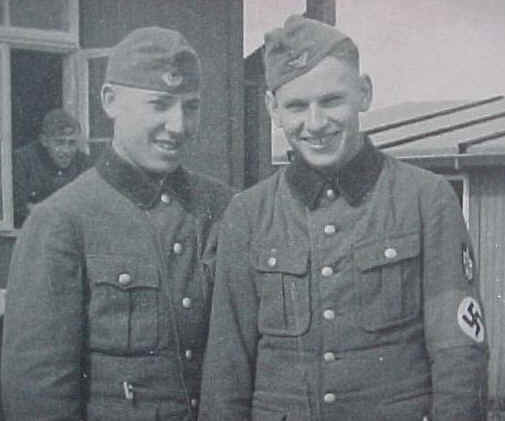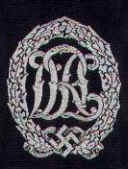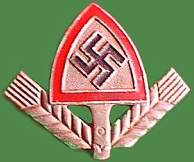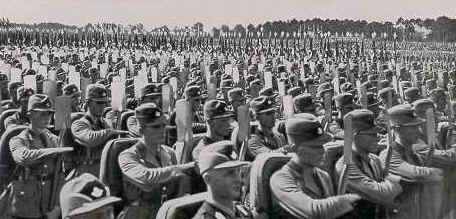| On the morning of Sunday, April 4, 1936, I woke early and
with great anticipation. I was to be at Augustus Square at nine o'clock to be
transported by bus to somewhere in Bavaria, where I would serve the next six months in
Reich Labor Service....At Augustus Square, I looked around at the milling crowd of young
men...hoping to see a familiar face, but I saw none. I did notice a figure in a
Labor Service uniform standing near three parked buses. Shortly before nine o'clock,
he bellowed in a voice of unbelievable volume: "All right! We are going to fill
these three buses front to back. I want every seat in the first bus full before a
man sets foot in the second. When I call out your name, get in the bus - on the
double." |
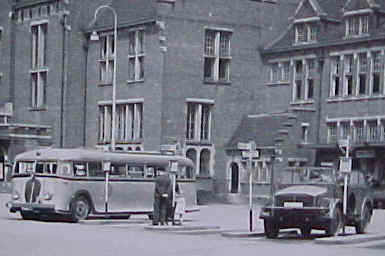 |
...By the time we arrived at our destination
at seven o'clock, it was almost dark. We were at the village of Burglengenfeld, near
the Czechoslovakian border. The Labor Service camp consisted of several small
buildings. The main building was a large former villa that had been remodeled to
house as many as 160 boys. As we grew quiet, the Labor Service man announced, in
that awe-inspiring voice he had used in the square, "Gentlemen, the commanding
officer of Burglengenfeld Labor Service Camp, Abteilungsführer Werner." He
drew himself stiffly to attention as a middle-aged man in a fancier Labor Service uniform
emerged through the door behind him.
The commanding officer appeared very straight and military as
he looked out over us in his neatly tailored uniform. "Welcome to
Burglengenfeld, men," he said, in a voice nearly as impressive as his
subordinate's. "Now you are proud Labor Service men." He continued
his brief prepared speech, informing us that our first four weeks would be training in
military drill and only then would we be permitted to go to work for the Fatherland....
The next morning, we were rudely awakened at five-thirty by
THE VOICE, bellowing with an unbelievable volume: "On your feet!"..."One
person from each room go to the mess hall and get breakfast for your room," he
ordered.
At promptly six-thirty, THE VOICE ordered us out into the
square in front of the building. We were divided into four squads and introduced to
our squad leaders....Each of the four squad leaders selected a different spot on the
soccer field, far enough apart that each could issue orders to his squad without causing
confusion among the other squads. (Squad Leader) Krupp, who seemed at ease and calm
about his duties and us, was a pleasant contrast to the constantly bellowing Brandt.
He patiently taught us first how to stand at "attention," then how to space
ourselves apart with an "eyes right!" maneuver. That was followed by how
to step off on our left heels at the command of "forward march," then how to
react to a "squad halt" command. We finished by learning how to do
"left face," "right face," and "about face."
| Finally, we were marched to the supply building and issued
uniforms. We were issued different uniforms for work, for parade, for exercising,
and for sports... In the afternoon, we attended an
hour-long class, mostly on the "New Greater German Reich."
...Following the training session, we were marched back to
the supply building, where we were each issued a shiny new spade...."Men,"
(Krupp) began, "this is the Labor Service, and this spade is the symbol of work and
toil. The spade you now hold will never touch dirt; it will be used strictly for
exercise and parades. At all times, your spade must sparkle as if it were made of
chrome. Since they are steel and not chrome, they will rust easily. Spot
inspections are to be expected." Krupp then offered instructions on how to
keep the spades clean by rubbing them with wet sand...and he advised us to work on the
spade every day rather than waiting until rust built up on it. |
 |
After another hour of drill in which we were
taught to march properly with the spades on our shoulders, we were finally released...
We spent the following four weeks learning military drill and
routine. An important function of the Labor Service was to free the Army from having
to do this very basic type of training. Everyone who went into Labor Service would
also be drafted into the Army, and we would enter the Army already partially trained.
...At the end of the four-week training period, we were
inspected by the camp commander and then released to begin our work detail. On our
first work day following our training period, we marched forty minutes to a strip coal
mine with "parade spades" on our shoulders. We fell out and stacked our
parade spades, like rifles, in four-spade pyramids. I worried about my spade,
because I kept it perfectly clean. I hated putting it in the stack with the others
from my squad for fear someone would grab mine and leave his rusted one for me to
clean. We were then issued working spades.
...The final leg of Labor Service occurred with the selection
of those of us who would parade at a huge political rally the government was planning to
stage at Nuremberg on September 8, 1936. The Army, the SA, the SS, the Labor
Service, and the Hitler Youth were all to parade in a grand spectacle.....
Only those of us who demonstrated the greatest skill on the
parade ground were selected. To my delight, I was among the 10 percent of my
Abteilung to go... Those selected to go to Nuremberg began to work less and do extra drill
in preparation for the rally. We practiced drilling by ourselves for two weeks, and
then we went to Amberg for two weeks of drilling in a company-size unit...
We went to Nuremberg, which was not far away, by bus.
We arrived the day before our parade and disembarked from the buses in the city. We
marched the two miles from Nuremberg to a virtual tent city that had been erected for all
of us...More than fifteen hundred tents, each accommodating six people, were arranged in
neat rows, with grass streets running between the rows of tents...

After the Nuremberg rally we returned...to finish our nearly
completed tour of duty with Labor Service....on September 24, 1936, we had a discharge
ceremony, ...we gave back our uniforms, put on our old civilian clothes, received our
final pay, and were released to go home. Although we had been brought to
Burglengenfeld by chartered bus, we were trusted to return on the train by ourselves.
Three weeks later...I boarded the train that would take me
from Leipzig to Jena, some forty miles away, to begin my new life as a soldier in the
artillery. |





